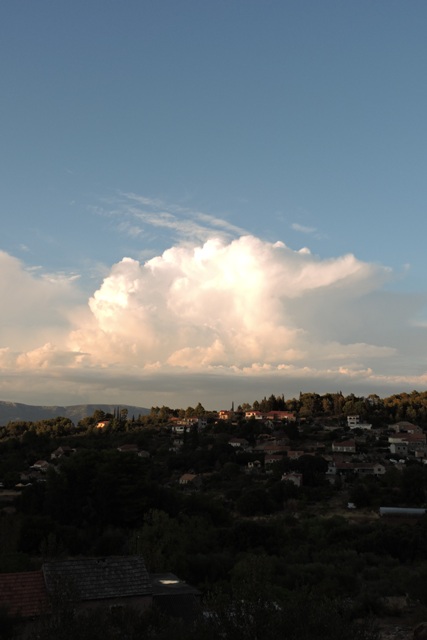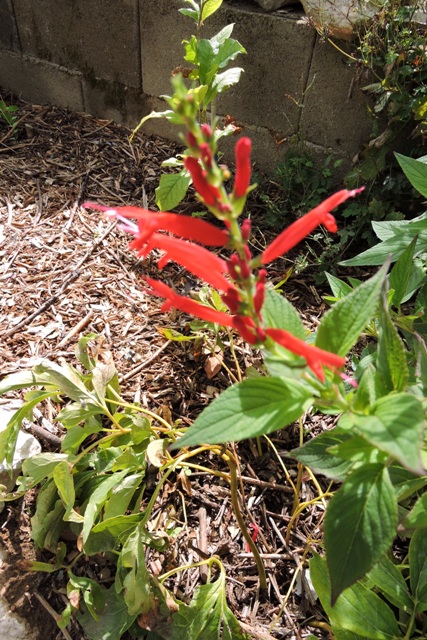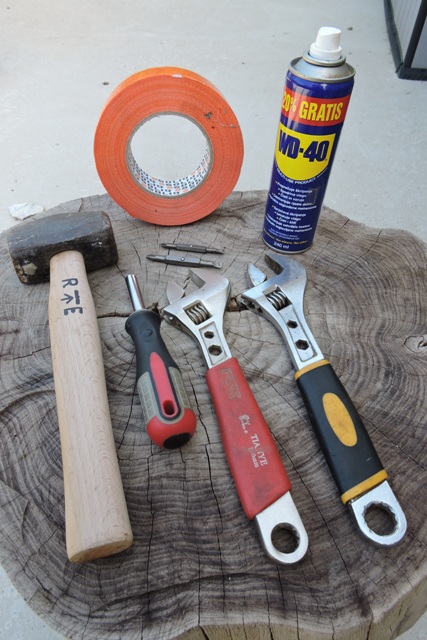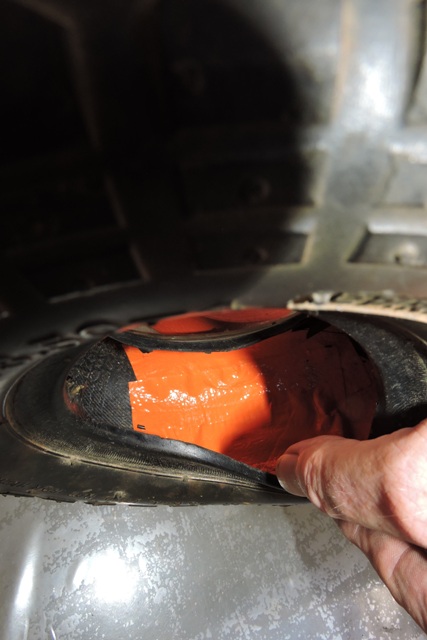Just 6 tools
This week: Just 6 tools; I hate Leap Years; My Marathon continues;

With 8 mm of rain falling between Thursday and Friday it has been the first rainfall of any significance since the beginning of June.
This has meant that I have not needed to irrigate, however even so, the land is so dry that with sun on Friday afternoon and Saturday morning, my thin soils were already drying out.
We are now back to the average temperatures to be expected in September. It is still hot when the sun shines, the sea is still warm, but the nights are cooler.
The combination of moisture and warmth have brought my Salvia shrub into flower.

This is taking over part of the border in the top orchard and flowers in both the spring and the autumn. I’m not sure exactly which Salvia it is though.
The leaves and flowers have no scent at all, so although it looks like Salvia Elegans, the Pineapple Sage, I don’t think it is.

It has taken just three days for some winter salad Rocket, Eruca vesicaria, to sprout after being sown.
I have also planted a row of early Broad Beans, and they have sprouted in just a few days as well.
Last year I planted the broad beans in cardboard tubes and then planted them out in October. This year I think I will just leave the two rows I have planted directly.
Just 6 tools
There is an old English saying, even a truism that “Necessity is the mother of invention”, and it is one I have used to good effect this week.
It was not a long job to fit the new wheel to my wheelbarrow. However I did have to make a pair of spacers from some old copper water pipe, to fit on the axle. That was easy and I now have a working vehicle again.
Waiting for the small replacement tyre for my big mulching machine, means that it is unavailable for use and I want to make use of its capacity to mulch cut branches.

When I looked at the tyre, there were several places where the rubber has perished. The mulcher has been kept under cover, so this isn’t a case of my leaving it out in the sunshine.

Perhaps it is just very poor quality tyres have been used.
I then had an idea. Mark the calendar because this doesn’t happen very often!
Going back to my flying days, we used to use a sticky tape on the front edge of the rotor blades.
Known as leading edge tape or 1,000 mph tape, it was protection to stop rain eroding the shiny front edge of the rotor blades.
Blades spin at very high speed and rain, dust or sand striking the blade at 800 mph will damage the stainless steel leading edge. A simple, easily replacable tape prevents this errosion.
The tape was inexpensive, unlike everything else related to helicopters and was easy to peel off and re-apply.
A version of this tape tape is on sale to the public and is known as as “Duct tape” or in the USA “Gaffer tape”.
It basically holds things together in a temporary repair. It is one of the six essential tools that EVERYONE should have.

These five tools are a 1) a roll of duct tape;
2) a Royal Engineers multi function tool, better known as a lump hammer;
3) a tin of WD40 or PlusGas ;
4) a screwdriver with flat and crosshead drivers;
5) a Metric adjustable spanner; and
6) an Imperial adjustable spanner.
You don’t believe me?

With these 6 tools you can fix anything and everything which has broken. Although the repairs may be somewhat temporary!
So, I dug deep into my stores and found a new roll of duct tape and then put short strips across the most damaged inside parts of the rubber tyre.

There was not a lot of working space, but I managed to get the tape in the right place, over the weak spots in the cover.

Gingerly I inflated the inner tube, then replaced the tyre on the mulching machine. It is only a temporary fix, but it will allow me to move the machine to at least do some work.
So these are the only six tools you ever really need……
I hate Leap Years
Do you ever think about leap years? Probably not.
They only happen every four years, are only ever in years with an even number, but do not fall if the even year is the first year of a new century. So not many rules to remember.
It was in 49 BC that Roman Emperor Julius Caesar reformed the Roman calendar to create leap days every four years, to save having to add intercalary months every few decades to keep the earth’s seasons in line with the annual calendar.
This year I have come to really dislike leap years. It is all to do with calculating 11 day running average temperatures.
I have discovered some interesting scientific research that shows that it is an 11 day average temperature which has the greatest effect on seed and plant growth.
Not five, seven or fourteen days, but precisely 11 days.
Thinking about using scientific research and principles to plan my planting programme for 2023 and onwards, I need to know from my weather station statistics, what the 11 day average is, for every day and for each week of the year.
I’ve spent a lot of time over the past couple of weeks updating my weather statistics spreadsheet, to give me important figures (for horticulturists).
Unsurprisingly with the global climate breakdown, there is increasing scientific research into the Cardinal temperatures of edible plants and vegetables.
The Cardinal temperatures are the point where seeds reliably germinate, where the plants grows best and fruits form, the temperature at which the plants starts to suffer from heat stress, and the temperature which causes plant death.
Using Microsoft Excel, you can automate a certain number of repetitive equations and I have completed an annual master workbook, then begun the task of back record conversion.
I have imported data from each year I have been here, into a new worksheet that includes the 11 day average and some other information on Cardinal temperatures .
Also included in the calculations were some checksums, to make sure that all the calculations and formulae were working properly.
On Tuesday as I was having a coffee break and was updating the 2016 data year, a leap year with a 29th March, I suddenly wondered if the spreadsheet took account of this.
And no it didn’t. This meant that each month after February, the error in the 11 day average was magnified.
Somewhat frustrated, I closed the programme and got another coffee.
I sought the advice of Excel gurus to see if there was a way of updating all the annual work books, without having to individually copy and paste the new formula…. It seems there isn’t.
My marathon continues
Once again I have spent a lot of hours this week slaving over a hot computer, creating formulae in my weather data spreadsheet.
I realised this would be a marathon not a sprint at the start but once done it will be a blueprint that can easily be replicated.
On a wet Thursday after finding out there is no way to easily copy multiple lines and cells, I finished the major part of the work manually.
It took some time to get everything right and then I did a couple of trial runs to see if the patterns I thought I could see in the data were actually there.
This chart shows that there is a pattern emerging.

Trying to see a pattern in rows of numbers is difficult, but when you see a graph or chart, thing start to make sense.
This shows that between May and September, the 11 day running average temperature has been above the average for the past years.
“But we knew that” I hear you say… Yes, for months there have been announcements that 2022 has been hotter than all previous years.
However what I can now both see and quantify, at any point in the year, is what the average temperatures should be. This turns mere statistics into useable information to inform me when to plant and when to expect die back because of the heat,
Although my weather station has only been in operation for eight years, which is a very small number for statistical purposes, it is the only data available on this side of the island.
What I have seen even in such a short time scale, is a change in weather patterns as climate breakdown intensifies.
I produce a bi-weekly weather forecast for this part of the island, with extra bulletins if I see an ESTOFEX weather warning, or I spot something like a storm which will affect Dol. However I would like my data to be of more use.
What I am trying to do is to predict exactly when seeds should be planted for rapid and successful germination, but also to see at what point the temperature will push growing vegetables into their heat stress state.
This varies by vegetable and by variety, however there is a growing body of research available to help.
My aim is to find and plant seeds, for example the tomato variety called Phoenix or Armenian Cucumbers, which will survive and fruit much longer in a hot summer than the varieties currently available here.
I’m getting there, but I still have more work to do… NCG
2 Responses
Rick Ellis
Mate,
I am thinking that you may earn a footnote, in the world of Excel, if you create a solution. However, you may need a wee dram in the coffee as you contemplate this. Stay safe and sane.
“I sought the advice of Excel gurus to see if there was a way of updating all the annual workbooks, without having to individually copy and paste the new formula…. It seems there isn’t.”
** Are you familiar with this site?: https://extension.arizona.edu/pubs/vegetable-planting-calendar-maricopa-county
(I know Arizona is in a different planting zone, but we have to deal with a lack of rain and heat also)
Marcy
Norman, Your ingenuity never ceases to amaze me. And your constant movement forward in all circumstances. It is really exciting to be a part of all you do, your innovation, adventures, and scientific experiments. Thank you for sharing.
BTW I love the Salvia. It’s so beautiful.